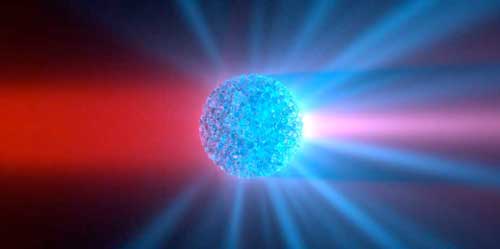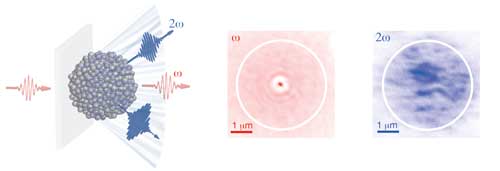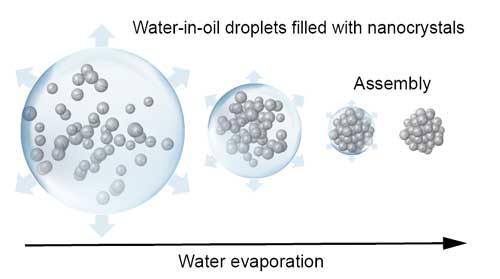| Oct 13, 2020 |
Well-formed disorder for versatile light technologies
(Nanowerk News) Researchers at ETH have managed to make an efficient material for broadband frequency doubling of light using microspheres made of disordered nanocrystals (Nature Photonics, "Broadband Mie-driven random quasi-phase-matching").
|
|
The crucial idea for the method arose during a coffee break. In the future, the new approach could be used in lasers and other light technologies.
|
|
From microscopes to data transfer via optical fibres all the way to modern quantum technologies, light plays an important role in science and industry. Particularly methods for changing the colour - and hence the frequency and wavelength - of light are of great importance in modern applications.
|
|
Those methods require the use of nonlinear crystals. In such crystals, two photons of a particular frequency can, for instance, be turned into one photon having twice that frequency - say, two red ones into a single blue one.
|
|
For that to work, however, the light typically has to hit the crystal in a specific direction and with a specific polarization. This so-called phase matching often severely limits practical applications.
|
 |
| Red light is transformed into blue light by frequency doubling inside tiny spheres made of nanocrystals. (Image: Jolanda Mueller / ETH Zurich)
|
|
A team of researchers led by ETH professor Rachel Grange at the Institute for Quantum Electronics, together with the group of Lucio Isa at the Department of Materials, have now developed a method by which efficient frequency doubling can be obtained without such fine tuning, and which also has other advantages compared to conventional methods.
|
Seemingly irreconcilable approaches
|
|
The researchers' recipe can be roughly summarized like this: rather small than large, and a mess is better than order. That sounds mysterious, but the task that Grange's team had set themselves was an equally big riddle: "For a better and more widely applicable frequency doubling, we wanted to combine two approaches that don't really fit together", says Romolo Savo, who led the project as a postdoc in the framework of a Marie-Sklodowska-Curie fellowship.
|
|
In the first approach, instead of a single large crystal one uses an assembly of lots of mini-crystals whose individual crystal axes point in random directions. In that way, it is no longer necessary to strictly control the directions of the incoming light beams. Among the many mini-crystals there will be some that are oriented favourably and some that are oriented unfavourably, but overall they will always produce a significant amount of frequency-doubled light.
|
|
"It sounds counterintuitive", Savo admits, "and some of our colleagues were truly puzzled by the idea of using disorder in that way - but it works!"
|
 |
| Inside the micrometre-sized spheres, the disordered nanocrystals frequency-double incoming red light into blue light (left). The blue light is emitted into different spatial directions (right). (Image: Romolo Savo / ETH Zurich) (click on image to enlarge)
|
|
The second approach is based on the enhancing action of resonances. If the assembly of mini-crystals is spherical, for instance, with a diameter roughly equal to the wavelength of the light, the intensity inside the sphere is increased manifold by repeated reflection of the light waves from the walls of the sphere, and hence also the yield of frequency doubled light.
|
|
Therefore, to make optimal use of both effects at the same time the researchers wanted to mould a disordered crystalline powder into micrometre-sized spheres in order to exploit the resonant enhancement of the light. The individual barium titanate crystals they intended to use for that purpose had to be very small, only around 50 nanometres in size, so that they were transparent enough to allow light to pass through them many times and thus create resonances in the microspheres.
|
A tip during the coffee break
|
|
"So, we had this great idea, but no clue as to how to turn the many tiny nanocrystals into perfect microspheres", says Savo. "Then, one day, we met Lucio Isa during the coffee break and told him about our problem - and he had an idea for us right there."
|
|
Isa's suggestion was to dissolve the nanocrystal powder in water, mix the solution with oil, and finally shake everything vigorously - similarly to what one would do with a vinaigrette made from vinegar and oil.
Inside the emulsion created by that process, tiny bubbles of the water-crystal solution will then form, from which the water gradually evaporates through the oil. In the end, tiny, perfectly shaped spheres of disordered nanocrystals remain, which is exactly what Grange and her collaborators were after.
|
 |
| Tiny spheres of nanocrystals are assembled by creating crystal-filled water droplets in an oil-water emulsion. The water evaporates, leaving behind perfectly shaped spheres. (Image: Romolo Savo / ETH Zurich)
|
|
"From that tip, the collaboration with Isa's group started", says Grange: "Incidentally, such spontaneous collaborations, which haven't been planned beforehand, are often the most fruitful. Of course, we immediately tried Isa's recipe."
|
Versatility plus material savings
|
|
And the recipe worked - even better than one might expect. "The frequency doubling with the tiny spheres made of disordered nanocrystals works independently of the direction of the incoming light as well as over a wide range of frequencies. This makes it much more versatile than frequency doubling with conventional crystals", Savo explains.
|
|
On top of that, the researchers obtained the same yield of frequency-doubled light using 70% less material. Contrary to ordinary crystals, for which the light yield stops growing beyond a certain size, it continued to increase with the volume of the microspheres.
|
High-quality laser crystals from powder
|
|
Grange and her colleagues now want to further improve their method, for instance by adding a spacer between the microspheres and the glass slide on which they rest. This should minimize light losses. The researchers have also started thinking about possible applications.
|
|
The prospect of producing high-performance nonlinear crystals from a simple and inexpensive nanocrystal powder is interesting for laser technologies in general. Also, it is possible to spread the microspheres over large areas. This could lead to the production of a new type of display that directly converts images in the infrared range into visible images by frequency doubling. Such displays could then be used in cameras for security and life-science applications.
|



